(gonarthrosis) does not affect life expectancy, but can seriously impair quality of life due to severe joint pain and limited mobility. Medical treatment for arthrosis of the knee joint helps to cope with pain and stop the progression of the disease. Read in this article: detailed characteristic the most effective means to date, which are guaranteed to help in treatment.
Patients were assessed before treatment initiation and 1 month, 3 months, and 6 months after treatment with a visual analogue scale for pain, the Western Ontario and McMaster Arthritis Index, and a time and onset test. Post-injection measurements were recorded by another physician to ensure blindness.
Medicines used during remission
It consists of 24 questions: 5 - from pain, 2 - from rigidity and 17 - from physical functions. You can calculate the scores for individual subgroups or the overall score. The Time Out and Go test was measured from the moment patients got up to sit with their feet on the floor with their hands resting on the arm of the chair. Patients were asked to stand up without using their hands, walk three meters, turn, walk, and sit down. The measurement ended when the subject's buttocks re-established contact with the chair.
Anesthetic ointments for gonarthrosis
If the pain is moderate, ointments based on drugs from the group of non-steroidal anti-inflammatory drugs (NSAIDs) will help get rid of it. Popular local remedies for arthrosis of the knee joint are ointments and gels with diclofenac and indomethacin.
Despite the fact that the ointments are applied superficially to the skin, they penetrate deep into the tissues, including the knee joint itself and even into the cartilage. NSAIDs have a pronounced anti-inflammatory and analgesic effect, so relief comes quickly.
Mean and standard deviation were calculated for continuous variables. The term "repeated measures" is strictly used for a treatment that is repeatedly administered to each subject, and the term "randomized block" is used to randomly assign treatment to a group of appropriate subjects. A repeated measurements experimental design can be very powerful as it controls the factors that cause variability between subjects.
One hundred and two patients were included in the study. Patients were randomly and equally divided into three treatment groups, and 98 patients completed the follow-up period. No significant complications were observed, except in cases of a short-term increase in local pain or edema during treatment and subsequent periods.
The advantage of ointments and gels for external use is their safety: they do not damage the mucous membrane of the stomach and intestines, do not negatively affect the body.
Oral knee pain medications
Four powerful medications:
A highly effective and inexpensive oral drug is paracetamol. It is significantly safer for the gastrointestinal tract than all other drugs for arthrosis, even the most modern, does not have negative effects on cardiovascular system does not affect blood pressure levels. But in alcohol abuse patients, acetaminophen can lead to serious health problems.
However, the effectiveness of one injection was significantly lower than the effectiveness of two or three injections. Accordingly, objective studies conducted using magnetic resonance imaging or arthroscopic techniques will be of value in this regard.
This study had certain strengths and limitations. The strength of this study was a prospective randomized design. The lack of a control group and relatively small patient numbers were a limitation of the study. Further studies with larger sample sizes with longer follow-up and objective results are needed.
Most of the drugs used to treat arthrosis belong to the group of so-called non-selective non-steroidal anti-inflammatory drugs. These are diclofenac, indomethacin, well-known to patients, and other effective agents.
The effectiveness of all NSAIDs is approximately the same. The main differences lie in the safety of drugs in this group. Ibuprofen, indomethacin and diclofenac are not selective: they not only suppress inflammation in the joints, but also provoke the formation of ulcers in the stomach and intestines, cause dangerous fluctuations in blood pressure, and can increase the risk of heart attack and stroke. Indomethacin, which is so popular among outpatient doctors and patients themselves, disrupts metabolic processes in the cartilaginous tissue, which is why the cartilage is destroyed faster.
This thick liquid can help relieve pain and swelling in your arthritis joint. The bones that make up your joints usually have a cap of cartilage at their ends. This cartilage helps make sure your bones move smoothly against each other. This cartilage has a liquid coating that contains hyaluronic acid. It works as a lubricant and shock absorber in your joint.
In osteoarthritis, this cartilaginous lid breaks down. When this happens, the bones in your joint stick together abnormally. People with osteoarthritis usually have less hyaluronic acid in their joints than they should. These all cause symptoms such as pain, stiffness, and swelling.
To date, the best ratio of efficiency and safety is possessed by Selective NSAIDs. They have a powerful anti-inflammatory effect in the tissues of the affected joint and practically do not affect the stomach, intestines, metabolic processes in cartilage, cardiovascular and coagulation systems. The disadvantage of selective NSAIDs is their high cost. In some situations, they are unambiguously chosen, for example, when it comes to patients over 65 years of age who have serious concomitant diseases or who are taking medications from the group of anticoagulants (heparin, fraxiparin and others) and glucocorticoids (prednisolone, dexamethasone, metipred).
Your supplier medical services may first inject numbness medicine into the space around your knee joint and possibly wipe off any fluid that is causing the joint to swell. Your healthcare provider will then inject hyaluronic acid into the space inside your joint. You shouldn't expect it to relieve your pain right away. However, after the full course of treatment, you may notice some pain relief.
You may have already tried other treatments for your arthritis, such as over-the-counter medications and corticosteroid injections. Treatment appears to be best for people with mild to moderate arthritis. Treatment can be of particular importance if you are trying to postpone joint surgery. You can talk with your healthcare provider about whether this is an option for your type of arthritis. Hyaluronic acid injection is not an option for treating arthritis in all types of joints.
Selective NSAIDs include celecoxib, rofecoxib, etoricoxib, and other coxibs. They are inferior to them in safety, but are still safer than indiscriminate NSAIDs such drugs as nimesulide, meloxicam.
With very severe pain caused by an exacerbation of arthrosis of the knee joint, the doctor may prescribe a prescription for tramadol. In fact, he is an opiate drug (opiates also include heroin, morphine). It copes well with pain, but very quickly becomes addictive, has multiple side effects on health, therefore it is used in exceptional cases.
What are the risks for treating arthritis with viscous filling therapy?
The knee is the standard injection site, but you can also get it for arthritis in the hip or possibly elsewhere. The most common problem you may encounter is a flare-up of arthritis right after the injection. This can cause additional pain and swelling in the short term. Healthcare providers are still researching the best methods to help reduce the chances of this complication.
Bleeding Allergic reaction Pain at the injection site Infection. ... There is also the possibility that treatment will not be effective in helping your symptoms. Talk to your healthcare provider about all of your concerns. Your own risks may vary depending on your medical conditions and where and how often you get the injections.
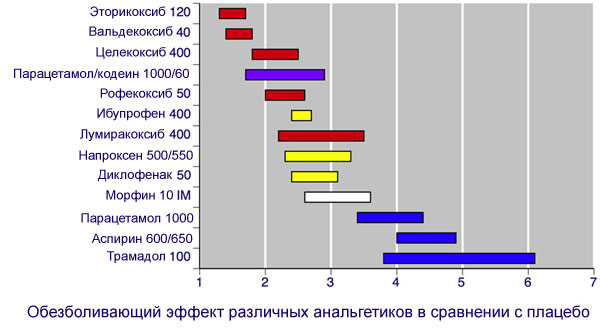
Click on the picture to enlarge
Medicines that repair damaged cartilage
It was previously believed that articular cartilage does not have the ability to self-renew. Recent Research proved the opposite. This was the impetus for the creation of drugs based on glucosamine, hyaluronic acid and chondroitin sulfate. With long-term use, glucosamine and chondroitin sulfate gradually restore the structure of the cartilage, so the progression of the disease stops, the pain decreases or disappears altogether, and the range of motion in the knee joints increases.
How to Prepare for Suction Treatment for Arthritis?
Talk to your doctor about all of your medical conditions... Tell your doctor about all medicines you take, including over-the-counter medicines like aspirin. Take all of your medicines as usual, unless your healthcare provider tells you otherwise.
On the day of your procedure, you can eat and drink as usual. Tell your doctor about any new symptoms, such as fever. You can wear loose clothing so you can easily expose your joint. Your healthcare provider may give you different instructions on what to do before your procedure.
Hyaluronic acid is not taken internally, but is injected into the cavity of the knee joint. It is injected 2-3 times a year, resulting in a tangible improvement in the function of the affected knee.
With severe osteoarthritis, drug treatment is ineffective. In such a situation, surgery is required.
Let's summarize
In order for the treatment to give the best effect and be safe for health, it must be prescribed by a doctor. Only he will be able to take into account all the data on concomitant diseases, drugs taken and choose the right treatment regimen. Be healthy!
What Happens During Treatment with Viscous Fill Therapy for Arthritis?
Typically, your healthcare provider will inject local anesthetic in the area around your joint so you will not feel pain or discomfort in the area during treatment. In some cases, your healthcare provider may use imaging so he or she can enter exactly at the right place. Your healthcare provider may use an ultrasound or other device that displays continuous x-rays. If you have excess fluid in your joint, your doctor may remove a small amount of fluid before starting. Your healthcare provider will inject hyaluronic acid into the joint space using a needle attached to a syringe. A small bandage will be applied to the injection site.
- Your healthcare provider will clean the area where you will have the injection.
- Instead, your healthcare provider may use an anesthetic.
Any joint problems require some control of the symptoms of the disease. The knee joint is no exception, since it is on it that the main load falls. The tactics of therapy differ in their methods and types, but all efforts are reduced to the fight against pain syndrome, its causes and the removal of general inflammation. Typically, traditional medicines for knee joints divided into groups, in accordance with the severity of the general condition of the patient.
Treatment of arthrosis depending on the stage of the disease
Depending on the type of product you are using, you may not need another shot, or you may need one to four more times over the next few weeks. You should be able to return home soon after your procedure. For about 48 hours, you should avoid standing for long periods of time, walking excessively, jogging, or lifting heavy loads.
Some people have mild pain, warmth, and swelling right after their procedure. These symptoms usually do not last long. Tell your doctor right away if these symptoms do not go away soon, or if you have intense warmth, redness, pain, or a high fever. Follow all instructions from your healthcare provider about medications and follow-up care.
For joint diseases, systemic therapy must be combined with the use of external agents (gels, creams, pastes and ointments), which help relieve symptoms and relieve pain. Some ointments and gels help restore damaged cartilage tissue. Indications and contraindications can be completely different even for drugs of the same group, therefore, treatment requires an individual approach to each patient.
Be sure to respect all of your future appointments. The procedure may not work effectively if you do not receive the full series of injections. You shouldn't expect your hyaluronic acid injection to immediately relieve your symptoms. It may take several weeks before you start to notice a difference. Your symptom relief may last for several months.
However, the procedure does not work for everyone. If the procedure doesn't work for you, keep talking to your doctor about other treatment options, such as joint surgery. Make sure you know before you agree to a test or procedure. When and where you should take the test or procedure Who will perform the test or procedure and what is the qualification of that person What happens if you did not have the test or procedure Any alternative tests or procedures to think about when and how you will get results Who should call after the test or procedure if you have questions or concerns. How much you will have to pay for the test or procedure.
- Test or Procedure Name The reason you have a test or procedure.
- What results are expected and what they mean.
- Risks and benefits of the test or procedure.
- What are the possible side effects or complications.
Traditional therapy involves the use of the following groups of drugs:
Outdoor
The main advantage of ointments and gels is considered to be ease of use and a fairly quick effect, and the disadvantage is the possibility of developing allergic reactions.
The list of ointments and gels is quite large, but their effectiveness is justified for arthrosis of 1-3 degrees, while with the development of stage 4, this method of therapy is not recommended.
What drugs are used to treat knee arthrosis?
The lower end of the femur, called the femur, rotates at the upper end of the lower leg, called the lower leg, and knee cap, or the patella, which slides into the groove at the end of the femur. Common diseases such as arthritis can damage the surfaces of the knee bone and the surrounding cartilage, causing pain and impairing function. A complete knee replacement can lead to significant improvements in quality of life and health. More than 90% of people who undergo a complete knee replacement surgery experience a significant reduction in knee pain and return to normal daily activities.
Local funds are conventionally divided into 3 groups:
1. Anti-inflammatory and pain relievers
This group includes NSAIDs that suppress the production of cyclooxygenase (an enzyme) that is responsible for activating inflammatory mediators. NSAIDs relieve pain symptoms and inflammation quite well, reduce swelling and lower body temperature. The result of the action of drugs in this group is the restoration of the mobility of the affected joints.
However, the decision to have a general knee replacement surgery should be made very carefully after consulting your doctor and learning as much as possible about the knee joint, your condition and the operation. The majority of patients who undergo a total knee replacement are between the ages of 50 and 80, although people of all ages are successful with this procedure. Surgery recommendations are based on your level of pain and disability, not your age. If, after an orthopedic evaluation, you and your surgeon decide that knee replacement surgery is the best way treatment, we will provide you with information on how to prepare for the procedure.
The main disadvantage of external anti-inflammatory drugs is the limitation of the depth of penetration (about 7% of the active substance). As a rule, NSAIDs are used at the initial stage of development, as well as during an exacerbation of the disease.
In the treatment of arthrosis of the knee joints, the following are most often used:
- Finalgel - used externally up to 4 times a day with a total duration of the treatment course from 1 to 4 weeks;
- Ketoprofen (Ketonal) - is a 2.5% gel or 5% cream and is used for 14 days (morning and evening);
- Nise-gel (Nimesulide) - the total duration of the treatment course is 10 days (3 times a day);
- this group also includes Diclofenac, Indomethacin, Movalis and Ibuprofen, which can be used in different forms... It is important to keep in mind that some of the external remedies are more suitable for large joints and vice versa.
All drugs in this group are applied in a thin layer, but have a number of contraindications, among which there is an individual intolerance to the components of the drug and the presence of damage to the skin. Most often, there is an allergic reaction to the use of NSAIDs, in second place are disorders of digestion and breathing, and prolonged use over a large area can lead to systemic side effects.
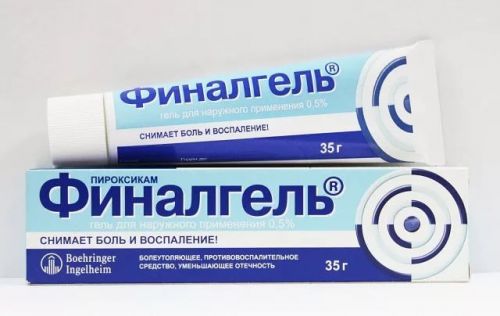
Finalgel is a transparent, slightly opalescent gel mass with a slight smell of alcohol
Despite the effectiveness of the use of external agents, they are used only in complex therapy, since in most cases, external agents relieve the external symptoms of the disease without affecting the cause of its occurrence.
2. Vasodilator and warming
The composition of the funds of this group, as a rule, contains snake or bee venom, turpentine, camphor, capsaicin, menthol and some other essential (sometimes synthetic) oils, which have a local irritating and distracting effect. Thanks to the activity of these drugs, blood supply and tissue trophism are restored, which is especially important in degenerative-dystrophic processes.
Warming ointments have a deeper effect on the tissues and not only relieve swelling and pain, but enhance the metabolic processes, nutrition and blood circulation of the joint. This leads to an increase in the volume of motor activity of the joint. Contraindications to the use of these drugs are dermatitis, skin damage and allergic reactions.
The group of vasodilators and warming agents includes:
- Finalgon - consists of a combination of 2 products (Nonivamide and Nicoboxil), applied to the area of inflammation with a special applicator and removed only with cream or vegetable oil;
- Capsicam is a synthetic vasodilator, which contains turpentine and camphor;
- Apizartron - this preparation contains methyl salicylate, mustard oil extract and bee venom. The medicine is actively rubbed into the affected area, followed by warming of this area;
- Efkamon (balm) - consists of herbal ingredients and is applied up to 3 times a day;
- Menovazin is a combined product at the most affordable price;
- Viprobel, Vipratox and Voltaren - the action of these funds is due to the presence of bee and snake venom in them;
- Espol - contains red pepper extract and Dimexide, which has an anti-inflammatory effect, enhancing the effectiveness of other components.
Not all ointments for knee joints belong to one of three groups, for example, Heparin ointment is a combined agent with a local anesthetic and anti-inflammatory effect, but its main purpose is to reduce blood clotting and prevent thrombus formation.

There are a number of drugs that can be classified as NSAIDs and vasodilators, such as Bom Benge or Viprosal
3. Chondroprotectors
These products contain components of cartilage tissue that improve metabolic processes in the affected tissues and slow down the process of degeneration. Ointments and gels of this group have a more pronounced regenerative effect, but it should be borne in mind that they are not able to completely prevent the destruction of cartilage tissue in the joint. Treatment with chondroprotectors is effective in the initial stage of joint changes, as well as as a prophylaxis for cartilage destruction.
Structum belongs to chondroprotectors. His active ingredient is the sodium salt combined with chondroitin. This remedy quickly relieves pain, restores cartilage and enhances joint nutrition. In addition, the chondroprotector has antioxidant and anti-inflammatory effects. Structum is available in capsules and is taken in a recommended dose of no more than 1000 mg per day.
With the help of drugs such as Chondroxide, you can relieve pain and increase joint mobility, preventing the progression of negative symptoms. In most cases, chondroprotectors are used in the form of a gel and ointment. The main component of Chondroxide is chondroitin sulfate, which enhances penetration through skin, having analgesic and anti-inflammatory effects.
The gel (ointment) is applied to the skin no more than 3 times a day, rubbing into the knee for 3-4 minutes until completely absorbed. In case of arthrosis, Chondroxide (ointment) is not recommended to be used for more than 3 weeks, while the gel can be used in a general course for up to 3 months.
There are very few contraindications to the use of chondroprotectors, most often it is hypersensitivity to the components of the drug, as well as the period of pregnancy, breast-feeding and violation of the integrity of the skin.
Oral
The following oral medications are most commonly used in the treatment of joint diseases:
Diclofenac
Diclofenac is rightfully considered the standard of conservative therapy, which, even with a large number drugs for the treatment of joints occupies a leading position. The action of the drug is due to the blocking of enzymes that provoke active inflammation.
Diclofenac relieves inflammation, has an analgesic effect, lowers overall body temperature and prevents degenerative pathological changes in the locomotor system. This drug is most effective in treating arthritis.
The dosage of Diclofenac is prescribed individually, depending on the severity of the symptoms. As a rule, adult patients are advised to take 25-50 mg. Diclofenac 2-3 times during the day. The average cost of a drug varies from 40 to 100 rubles per package.
Artra
The drug contains glucosamine hydrochloride and chondroitin sulfate. The indications for the treatment of Arthra are osteochondrosis spinal column and other disorders of the functionality of the joint. The drug is prescribed in 2 pcs. (250 mg) 2 times a day, 1 t. (500 mg.) 2 times a day or 1-2 pcs. (750 mg) per day. The price of the medicinal product ranges from 700 to 1600 rubles.
Dona's active ingredient is glucosamine sulfate and auxiliary components. Don is often used in the treatment of knee diseases, since the active substance of the drug effectively restores metabolic processes in the cartilaginous tissue, reduces pain symptoms and inhibits the degenerative process.
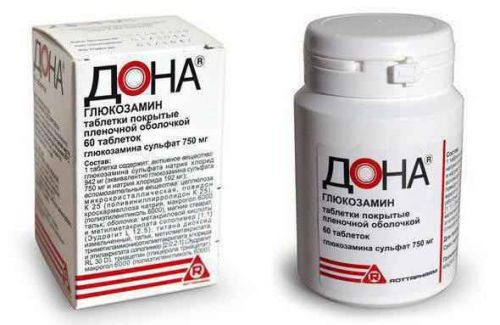
Don's drug is taken 1 sachet once a day for 1.5 months. The average cost of the drug is 1200 rubles
Chondroitin AKOS
This remedy is prescribed to get rid of osteochondrosis, arthrosis and cartilage damage. Chondroitin AKOS relieves inflammation, pain symptoms and normalizes the metabolism that develops in the cartilage tissue, stopping its destruction in the future. Chondroitin AKOS is taken orally 2 TB. 2 times a day, which is 1000 mg. The average cost of a drug is 260 rubles.
Teraflex
This combined remedy effectively slows down the process of destruction in the cartilage tissue, contributing to a quick healing. In the first 20 days, you need to take 1 TB. (in the morning, at lunchtime and in the evening), then 1 TB is taken. 2 times a day. The duration of the general course is 2 - 3 months. The average cost of a medicine is about 1,500 rubles.
Chondroxide
This drug accelerates the regenerative processes in the damaged tissues of the joint, reducing pain symptoms. Chondroxide is taken orally at 0.5 g. (2 TB.) 2 times during the day. The price of the drug ranges from 300 to 500 rubles per package.
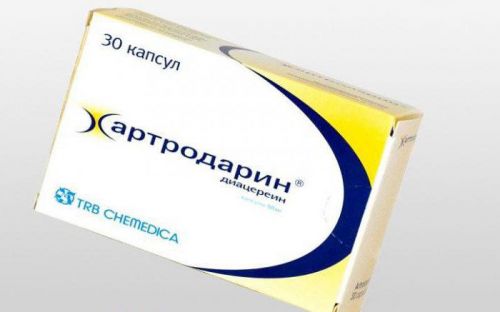
In addition to the above agents, which are used in the traditional therapy of arthrosis and osteochondrosis, Arthrodarin (another name for this drug is Diaflex), which is produced in the form of capsules that have an anti-inflammatory effect, is now widely used.
The mechanism of action of Arthrodarin differs significantly from NSAIDs, as well as glucocorticosteroids, primarily in the absence of characteristic side effects that occur when taking NSAIDs. It is important to take into account that all these funds have a temporary effect, only inhibiting the inflammation process, and complex therapeutic treatment is required for complete recovery.
Injections
One of the effective therapeutic methods for inflammatory processes in the knee area is the injection of drugs, including hormonal ones, into the cartilage, thereby exerting a quick effect on it. This method of therapy involves the use of the following drugs:
Hyaluronic Acid (Sodium Hyaluronate)
This remedy has been used for a long time in the treatment of arthrosis and arthritis, as it has a nourishing and moisturizing effect. Hyaluronic acid creates a protective sheath in the joint, thereby protecting it from destruction.
Hydrocortisone
This remedy belongs to the hormonal and is prescribed in the case when all other drugs are ineffective. Corticosteroids can quickly relieve negative manifestations, but it should be borne in mind that they have serious side effects, for example, frequent and prolonged use can lead to the destruction of cartilage tissue.
Diprospan
This remedy belongs to glucocorticosteroids and is used for arthrosis quite rarely (no more than 1 time per 7 days) so as not to worsen the patient's condition.
Flosterone
The composition of this drug includes betamethasone, which has the fastest possible effect on the inflamed skin. Flosterone is recommended for use in cases of severe swelling and pain.
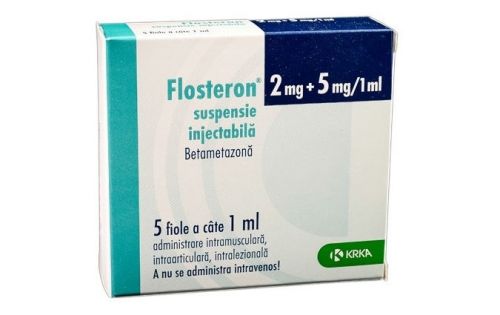
Flosterone is available in the form of a suspension for injection and in the form of ampoules (1 ml each) 5 pcs. packaged
Celeston
This hormonal agent rapidly reduces the process of inflammation in the cartilage tissues of the joint, which helps to reduce pain symptoms. Celeston helps well when injected and is not administered orally due to the risk of side effects.
Kenalog
The active substance of Kenalog is triamcinolone, which helps to stop inflammatory process... The use of Kenalog is not recommended with an increased risk of developing an infectious process in the area of inflammation.
Hondrolone
The drug helps to get rid of inflammation and pain, accelerates the regeneration of bone and cartilage tissue, and improves metabolic processes. The medicine is recommended for patients with arthrosis of 1 and 2 degrees. Chondrolone is injected intramuscularly in 1 ampoule every other day.
Elbona
This drug is injected deep into the gluteus muscle (2 ml each), previously diluted with water for injection, once a day (3 times a week). The total duration of the therapeutic course is from 1 to 1.5 months. Elbona allows you to relieve inflammation, pain, and prevent joint destruction.
When prescribing injectables to combat joint diseases, the doctor must take into account the results diagnostic activities and the general condition of the patient.
Stem cells
Perhaps the most powerful effect in the treatment of joints is stem therapy. The action of stem cells is due to the activation of metabolic processes in the body, as well as the stimulation of nutrition in the affected joint.
Thanks to the use of such remedies, joint pain is sharply reduced, and in some cases even disappears altogether. When treating joints, stem cells can be injected locally into the affected area, or applied systemically.
One of these drugs is Kartistem, which is injected into the periarticular tissues. As a rule, the use of stem cells is not accompanied by side effects, despite the fact that an improvement in the condition is noted after the first 2-3 injections. In addition, stem cell therapy avoids possible replacement of the affected joint.
Quite often, the development of joint diseases is associated with a lack of vitamins in the body, which provide tissue nutrition. To replenish the lack of vitamins, first of all, it is recommended to include in food products with a high content of vitamins of groups B, C and E. In addition, you should give up bad habits such as smoking and alcohol.

A complex of vitamins is prescribed not only to improve the condition of the articular ligaments and cartilage tissue, but also to reduce the inflammatory process, as well as increase the patient's immune defense
Most often, tableted complex vitamins are prescribed, however, in severe cases, injection of vitamins of group D, A, PP and B is possible.
Dietary supplements
In the treatment of joint diseases, along with traditional means, dietary supplements and homeopathic medicines (Traumeel, Purpose - T, etc.) are often used.
The most famous and demanded in this group are:
- Piascledin (capsules) - this product contains polyunsaturated fatty acids of avocado and soybeans. Numerous studies show that the interaction of these components effectively prevents the destruction of articular cartilage;
- Artrofoon (sublingual granules) - belong to the homeopathic group of medicines and are taken in accordance with the doctor's recommendation;
- Triaste (tablets, cream) - this drug is a source of glucosamine and chondroitin sulfate and is available in 2 forms. Reception of Triaste must be agreed with the doctor. After the external application of the cream, a regenerating and analgesic effect is noted, due to the cinnamon oil and auxiliary components included in the drug.
It must be remembered that all medicines for the knee joint, they act ambiguously with various therapeutic regimens, therefore, before starting their use, it is recommended to first consult a doctor. Self-medication can dramatically worsen the situation and lead to the transformation of an acute process into a chronic form, which is much more difficult to treat.
